18. Working Together with Adobe Programs
Introduction
Adobe programs are designed to work together so you can focus on what you need to do, rather than on how to do it. In fact, the Adobe programs share tools and features for your most common tasks so you can work uninterrupted and move seamlessly from one program to another. Adobe Creative Suite is an integrated collection of programs that work together to help you create designs in print, on the Web, or on mobile devices. When you install Adobe Creative Suite or a stand-alone Adobe program, you also get additional Adobe programs and services—Bridge, CS Live, ConnectNow, Device Central, Extension Manager, and ExtendScript Toolkit—to help you perform specific jobs, such as locating, downloading, and modifying images for projects, managing files and program extensions, testing files for different mobile devices, and creating scripts.
Adobe Bridge is a program that lets you view, open, modify, and manage images located on your computer from any Adobe Creative Suite program. Adobe Bridge is literally the glue that binds Adobe Creative Suite programs together into one cohesive unit with shared tools. Bridge allows you to search, sort, filter, manage, and process image files one at a time or in batches. You can also use Bridge to do the following: create new folders; rename, move, delete and group files; edit metadata; rotate images; create web galleries and contact sheets; and run batch commands. You can also import files from your digital camera and view file information and metadata.
Exploring Adobe Programs
Adobe Creative Suite
Adobe Creative Suite is an integrated collection of programs that work together to help you create designs in print, on the Web, or on mobile devices. Adobe’s Creative Suite comes in different editions with different combinations of Adobe programs. The main programs for print design include InDesign and Acrobat Professional; for graphic design the programs include Photoshop, Illustrator, and Fireworks; for video and sound design the programs include Premiere, After Effects Professional, Encore, and Soundbooth; and for web design the programs include Flash Professional, Dreamweaver, Fireworks, and Contribute.
Working Together with Adobe Programs
When you install Adobe Creative Suite or a stand-alone Adobe program, you also get additional Adobe programs—Bridge, CS Live, ConnectNow, Device Central, Extension Manager, and ExtendScript Toolkit—to help you perform specific jobs such as managing files and program extensions and testing files for mobile devices.
Adobe Bridge
Adobe Bridge is a file management/batching program that manages and processes images while you work. To use Bridge, click Browse in Bridge on the File menu or the Go to Bridge button on the Applications bar within an Adobe CS product or from the desktop use the Start menu (Win) or go to the Applications folder (Mac).
Adobe CS Live
Adobe CS Live (New!) is an online service that allows you to set up or manage (sign in and out) an Adobe account, review CS5 documents (Illustrator, InDesign, and Photoshop) online, access the Acrobat.com subscription-based Web site or the Adobe ConnectNow Web site where you can collaborate with others, display CS news and resources in a panel within CS5 programs, and access an Adobe Web site with information about CS Live Services. You can access these options directly from the CS Live menu on the right side of the menu bar next to the Search bar.
Adobe ConnectNow
The Share My Screen command on the File or CS Live menu allows you to connect to Adobe ConnectNow, which is a secure Web site where you can start an online meeting. You can share and annotate your computer screen or take control of an attendee’s computer. During the meeting, you can communicate by sending chat messages, using live audio, or broadcasting live video.
Adobe Device Central
Adobe Device Central allows you to test your content to see how it would look on a variety of mobile devices. You can interact with the emulated device in a way that allows you to test your content in real-world situations. Device Central provides a library of devices and each device includes a profile with information about the device, including media and content support types.
Adobe Extension Manager
Adobe Extension Manager allows you to install and delete added program functionality, known as extensions, to many Adobe programs.
Adobe ExtendScript Toolkit
Adobe ExtendScript Toolkit allows you to create, edit, and debug JavaScript to be used for scripting Adobe programs.
Exploring Adobe Bridge
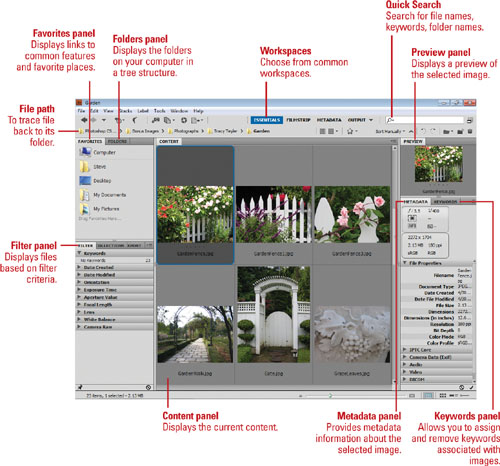
Getting Started with Adobe Bridge
Adobe Bridge is a stand-alone program that lets you view, open, and manage images located on your computer from any Adobe Creative Suite program. Adobe Bridge is literally the glue that binds Adobe Creative Suite programs and shared tools together into one cohesive unit. Adobe Bridge integrates with shared tools including Adobe Version Cue, a file tracking project management program. The Bridge program provides a set of panels that make it easy to find, view, and manage the files on your computer or network. As you work with Bridge, you’ll open, close, and move (dock and undock) the panels to meet your individual needs. After you customize the workspace, you can save the location of the panels as a custom workspace, which you can display using the Workspace command on the Window menu. Bridge also provides some predefined workspaces.
Get Started with Adobe Bridge
![]() Launch your Adobe product, click the File menu, and then click Browse in Bridge.
Launch your Adobe product, click the File menu, and then click Browse in Bridge.
• You can also click the Go to Bridge button on the Application bar. Ctrl (Win) or ![]() (Mac)+ click for a maximized view, Alt (Win) or Option (Mac)+click to open a new Bridge window, or Shift+click to open Mini Bridge.
(Mac)+ click for a maximized view, Alt (Win) or Option (Mac)+click to open a new Bridge window, or Shift+click to open Mini Bridge.
• You can also start Adobe Bridge from the Start menu (Win) or the Applications folder (Mac).

![]() To open and close a panel, click the Window menu, and then click the panel name you want.
To open and close a panel, click the Window menu, and then click the panel name you want.

![]() To move a panel, drag the panel tab you want to another location in the Bridge window.
To move a panel, drag the panel tab you want to another location in the Bridge window.
![]() To save a workspace, click the Window menu, point to Workspace, click New Workspace, type a name, and then click OK.
To save a workspace, click the Window menu, point to Workspace, click New Workspace, type a name, and then click OK.
![]() To display a workspace, click the Window menu, point to Workspace, and then click the workspace you want.
To display a workspace, click the Window menu, point to Workspace, and then click the workspace you want.
![]() When you’re done, click the Close button in the Bridge window.
When you’re done, click the Close button in the Bridge window.
Getting Photos from a Digital Camera
If you have raw or other images from your digital camera, you can use the Get Photos from Camera command in Adobe Bridge to retrieve and copy them to your computer. This allows you to specify where you want to store the files, rename them if you want, preserve metadata, or convert them to the DNG format. When you convert raw files to the DNG format, you specify preview size, compression, and whether to preserve the raw image data or embed the original raw file.
Import Raw and Other Files from a Camera
![]() In Adobe Bridge, click the File menu, and then click Get Photos from Camera or click the camera icon on the Application bar.
In Adobe Bridge, click the File menu, and then click Get Photos from Camera or click the camera icon on the Application bar.
![]() Click the Get Photos From list arrow, and then select the source camera or memory card.
Click the Get Photos From list arrow, and then select the source camera or memory card.
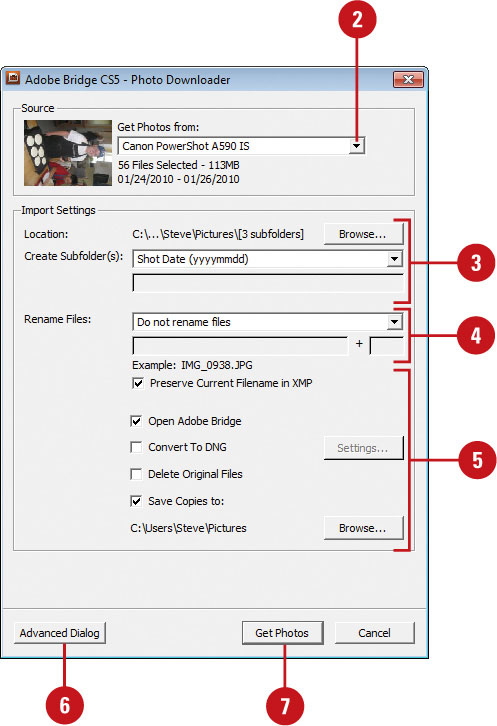
![]() Click the Browse button to select a folder location, and then create a new subfolder to store the images (optional).
Click the Browse button to select a folder location, and then create a new subfolder to store the images (optional).
![]() To rename the files, select a method, and then enter file name text.
To rename the files, select a method, and then enter file name text.
![]() Select the options you want:
Select the options you want:
• Preserve Current Filename in XMP. Select to save the current filename as image metadata.
• Open Adobe Bridge. Select to open and display the files in Adobe Bridge.
• Convert To DNG. Select to convert Camera Raw files to DNG. Click Settings to set DNG conversion options.
• Delete Original Files. Select to delete original files from camera or memory card.
• Save Copies To. Select to save copies to another folder for backup.
![]() To apply metadata to the files, click Advanced Dialog.
To apply metadata to the files, click Advanced Dialog.
![]() Click Get Photos.
Click Get Photos.
Working with Raw Images from a Digital Camera
Raw image file formats are created by most mid- to high-end digital cameras and contain information about how the image was taken. The raw format turns off all camera adjustments, and simply saves the image information. Using the raw format is as close to using traditional film as a digital camera can get. Raw images are larger; however, the increase in file size gives you more information that can be used by Camera Raw to adjust the image. From Adobe Bridge, you can use Camera Raw to open raw files, JPEG, and TIFF files to make image enhancements. If you’re not sure what to do, you can click Auto to have Camera Raw do it or drag color sliders to adjust options manually. You can adjust color tones, reduce noise (New!), add grain (New!), add sharpening (New!), correct for lens defects, add post-crop vignetting and effects (New!), and retouch images with the Heal, Clone and Red Eye tools. Raw images can be converted into 16-bit images. When you use a 16-bit image, you have more control over adjustments such as tonal and color corrections. Once processed, raw images can be saved in the DNG, TIFF, PSD, PSB, or JPEG formats. After you make Camera Raw adjustments, you can save the settings so you can use them later.
Set Camera Raw Preferences
![]() In Adobe Bridge, click the Edit (Win) or Adobe Bridge (Mac) menu, and then click Camera Raw Preferences.
In Adobe Bridge, click the Edit (Win) or Adobe Bridge (Mac) menu, and then click Camera Raw Preferences.
![]() Select the preferences you want:
Select the preferences you want:
• General. Specify where Camera Raw file settings are stored. Use Sidecar XMP files to store settings separately, or Camera Raw Database to store settings in a searchable database.
• Default Image Settings. Select options to automatically apply settings or set defaults.
• Camera Raw Cache. Set a cache size to shorten loading time for thumbnails and previews.
• DNG File Handling. Select options to ignore XMP files or update embedded content.
• JPEG and TIFF Handling. Automatically open JPEGs and/or TIFFs in Camera Raw.
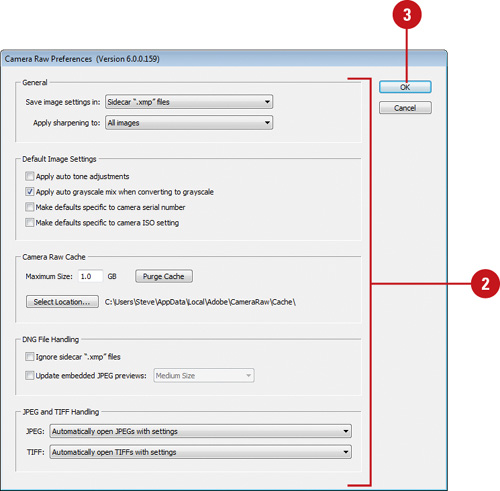
![]() Click OK.
Click OK.
Modify a File in Camera Raw
![]() Right-click the image(s), and then click Open in Camera Raw.
Right-click the image(s), and then click Open in Camera Raw.
![]() Use the Zoom, Hand, Rotate, Crop, and Straighten tools to change the size, orientation, and position of the image, or use the White Balance tool to set the white balance or the Color Sampler tool to sample a color, or use the Retouch and Red Eye Removal tools to correct the image. Use the Adjustment Brush and Graduated Filter for local adjustments.
Use the Zoom, Hand, Rotate, Crop, and Straighten tools to change the size, orientation, and position of the image, or use the White Balance tool to set the white balance or the Color Sampler tool to sample a color, or use the Retouch and Red Eye Removal tools to correct the image. Use the Adjustment Brush and Graduated Filter for local adjustments.

![]() Select any of the view options:
Select any of the view options:
• Image Preview. Displays the active image.
• Zoom Level. Changes the view of the active image.
• Histogram. Displays information on the colors and brightness levels in the active image.
![]() Click the Basic, Tone Curve, Detail, HSL/ Grayscale, Split Toning, Lens Corrections, Effects (New!), Camera Calibration Presets, or Snapshots (New!) tabs, and then click Auto (Basic tab) or drag sliders to modify the color and tonal values.
Click the Basic, Tone Curve, Detail, HSL/ Grayscale, Split Toning, Lens Corrections, Effects (New!), Camera Calibration Presets, or Snapshots (New!) tabs, and then click Auto (Basic tab) or drag sliders to modify the color and tonal values.
![]() Click Save Image to specify a folder destination, file name, and format for the processed images.
Click Save Image to specify a folder destination, file name, and format for the processed images.
![]() Select the images you want to synchronize (apply settings) in the Filmstrip (if desired, click Select All), and then click Synchronize.
Select the images you want to synchronize (apply settings) in the Filmstrip (if desired, click Select All), and then click Synchronize.
![]() Click the Camera Raw Menu button to Load, Save, or Delete a specific set of Raw settings, or to modify dialog box settings.
Click the Camera Raw Menu button to Load, Save, or Delete a specific set of Raw settings, or to modify dialog box settings.
![]() Click Done to process the file, but not open it, or click Open Image to process and open it in Photoshop. Hold Alt (Win) or Option (Mac) to use Open Copy or Reset.
Click Done to process the file, but not open it, or click Open Image to process and open it in Photoshop. Hold Alt (Win) or Option (Mac) to use Open Copy or Reset.
Working with Images Using Adobe Bridge
With Adobe Bridge, you can drag assets into your layouts as needed, preview them, and add metadata to them. Bridge allows you to search, sort, filter, manage, and process image files one at a time or in batches. You can also use Bridge to create new folders; rename, move, delete and group files (known as stacking); edit metadata; rotate images; and run batch commands. You can also view information about files and data imported from your digital camera.
Work with Images Using Bridge
![]() Launch your Adobe product, click the File menu, and then click Browse in Bridge, or click the Launch Bridge button (if available).
Launch your Adobe product, click the File menu, and then click Browse in Bridge, or click the Launch Bridge button (if available).
![]() Click the Folder path, and then select a folder.
Click the Folder path, and then select a folder.
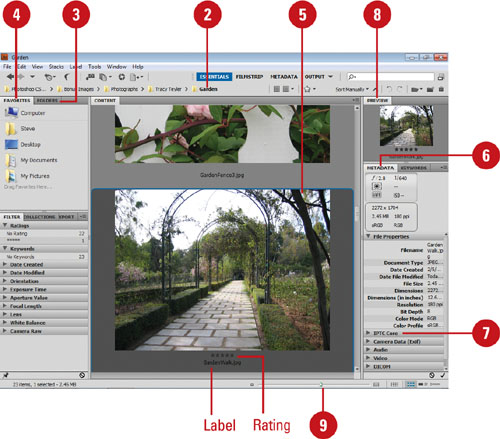
![]() Click the Folders tab and choose a folder from the scrolling list.
Click the Folders tab and choose a folder from the scrolling list.
![]() Click the Favorites tab to choose from a listing of user-defined items, such as Pictures or Version Cue.
Click the Favorites tab to choose from a listing of user-defined items, such as Pictures or Version Cue.
![]() Click an image within the preview window to select it.
Click an image within the preview window to select it.
![]() Click the Metadata tab to view image information, including date and time the image was shot, and aperture, shutter speed, and f-stop.
Click the Metadata tab to view image information, including date and time the image was shot, and aperture, shutter speed, and f-stop.
![]() Click the IPTC Core arrow to add user-defined metadata, such as creator and copyright information, or captions.
Click the IPTC Core arrow to add user-defined metadata, such as creator and copyright information, or captions.
![]() Click the Preview tab to view a larger thumbnail of the selected image. Multiple images appear when you select them.
Click the Preview tab to view a larger thumbnail of the selected image. Multiple images appear when you select them.
• Click the image in the Preview tab to display a Loupe tool for zooming. Drag magnified box to change positions. Click it to deactivate the tool.
![]() Drag the Zoom slider to increase or decrease the thumbnail views.
Drag the Zoom slider to increase or decrease the thumbnail views.
![]() Click the preview buttons to select a different view of the workspace you have chosen. If you want to view your images in filmstrip or metadata focus mode, choose that workspace from the Window menu.
Click the preview buttons to select a different view of the workspace you have chosen. If you want to view your images in filmstrip or metadata focus mode, choose that workspace from the Window menu.
• View Content as Thumbnails. Default view. Displays the images as thumbnails with the file name underneath.
• View Content as Details. Displays a thumbnail of each image with selected details about the image such as date created, document type, resolution.
• View Content as List. Displays a small thumbnail of each image with metadata information details, such as date created and file size.

![]() Use the file management buttons to rotate or delete images, or create a new folder.
Use the file management buttons to rotate or delete images, or create a new folder.
![]() To narrow down the list of images using a filter, click the criteria you want to use in the Filter panel.
To narrow down the list of images using a filter, click the criteria you want to use in the Filter panel.
![]() To add a label or rating to images, select the ones you want, click the Label menu, and then select the label or rating you want.
To add a label or rating to images, select the ones you want, click the Label menu, and then select the label or rating you want.
![]() To group related images as a stacked group, select the images, click the Stacks menu, and then click Group as Stack.
To group related images as a stacked group, select the images, click the Stacks menu, and then click Group as Stack.
• Use the Stacks menu to ungroup, open, expand, or collapse stacks.
![]() Double-click on a thumbnail to open it in the default program, or drag the thumbnail from Bridge into an open Adobe application.
Double-click on a thumbnail to open it in the default program, or drag the thumbnail from Bridge into an open Adobe application.
Setting Preferences in Adobe Bridge
Adobe Bridge allows you to set preferences to customize the way you work. The Preferences dialog box is organized into categories—including General, Thumbnails, Playback, Metadata, Keywords, Labels, File Type Associations, Cache, Startup Scripts, Advanced, and Output. You can set specific options within these categories to suit your particular needs. For example, you can choose to display more metadata information with thumbnails, such as dimensions, size, keywords, color mode, label, etc.
Set Bridge Preferences
![]() In Adobe Bridge, click the Edit (Win) or Bridge (Mac) menu, and then click Preferences.
In Adobe Bridge, click the Edit (Win) or Bridge (Mac) menu, and then click Preferences.
![]() Click the General category.
Click the General category.
![]() Select the appearance, behavior, and Favorite Items you want.
Select the appearance, behavior, and Favorite Items you want.
![]() Click the Thumbnails category.
Click the Thumbnails category.

![]() Specify the performance and details options you want:
Specify the performance and details options you want:
• Performance and File Handling. Choose the maximum size of file to be processed (default: 1000 MB).
• Details. Select the metadata details you want to show with the thumbnail.
![]() Click the Metadata category.
Click the Metadata category.

![]() Select the check boxes with the metadata you want and clear the ones you don’t want.
Select the check boxes with the metadata you want and clear the ones you don’t want.
![]() Click the Labels category.
Click the Labels category.
![]() Enter names for labels you want to be associated with a specific color.
Enter names for labels you want to be associated with a specific color.
![]() Click the File Type Associations category.
Click the File Type Associations category.

The left column displays the file type and the right column displays the current program that will open the file by default.
![]() To change the default program, click the list arrow next to the file type, and then select a program or choose Browse to locate another application you would like to use.
To change the default program, click the list arrow next to the file type, and then select a program or choose Browse to locate another application you would like to use.
![]() Click the Cache category.
Click the Cache category.
![]() Choose where to store the cache, choose a cache size, and optimize or purge the cache from here.
Choose where to store the cache, choose a cache size, and optimize or purge the cache from here.
![]() Click the Startup Scripts category.
Click the Startup Scripts category.

![]() Select the check boxes with the programs you want to enable and clear the ones you want to disable.
Select the check boxes with the programs you want to enable and clear the ones you want to disable.
![]() Click the Advanced category, and specify whether to use software rendering and monitor-size previews, and then choose the language and keyboard options you want. You can also choose to have Bridge start automatically at login.
Click the Advanced category, and specify whether to use software rendering and monitor-size previews, and then choose the language and keyboard options you want. You can also choose to have Bridge start automatically at login.
![]() Click OK.
Click OK.
Did You Know?
You can use Photoshop automation commands in Adobe Bridge. You can use the Batch or Image Processor commands on the Tools menu under Photoshop In Bridge to automate the processing of your camera’s raw files.
Applying Image Adjustments
Adobe Bridge makes it easy to make adjustments to one image in Camera Raw and then apply those adjustments to other images directly from Bridge without going back into Camera Raw. For instance, you may be correcting the white balance for an image and have many other images that were shot at the same time, under the same lighting conditions. You can use the initial settings to correct the rest of your images right from Bridge. You can also make a preset from your favorite adjustments, which will then be available as a develop setting within Bridge.
Modify Images in Adobe Bridge
![]() In Adobe Bridge, display and select the images that you want to adjust.
In Adobe Bridge, display and select the images that you want to adjust.

![]() Use any of the following methods to modify an image:
Use any of the following methods to modify an image:
• Apply a Preset Adjustment. Click the Edit menu, point to Develop Settings, and then select a preset adjustment.
• Copy and Paste Settings. Click the Edit menu, point to Develop Settings, and then click Copy Settings. Select the image(s) to which you want to apply the settings. Click the Edit menu, point to Develop Settings, and then click Paste Settings. Select the options to apply, and then click OK.
• Apply the Most Recent Adjustment. Click the Edit menu, point to Develop Settings, and then click Previous Conversion.
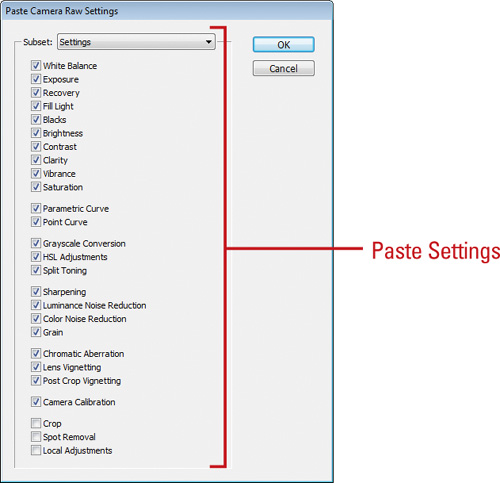
Did You Know?
You can use Photoshop automation commands in Adobe Bridge. You can use the Batch or Image Processor commands on the Tools menu under Photoshop in Bridge to automate the processing of your camera’s raw files.
Creating a Web Photo Gallery
Adobe Bridge takes the drudgery out of creating a Web Photo Gallery (thumbnail images on web pages). The pages generated with this command display small thumbnails of a group of images—when you click on an image, a larger version is displayed within another window or section of the page. If your goal is to show the world your photographs, but you don’t want to write all the HTML code involved in making that happen, then the Web Photo Gallery is just what you need.
Create a Web Photo Gallery in Adobe Bridge
![]() In Adobe Bridge, select the images that you want to use for the photo gallery.
In Adobe Bridge, select the images that you want to use for the photo gallery.
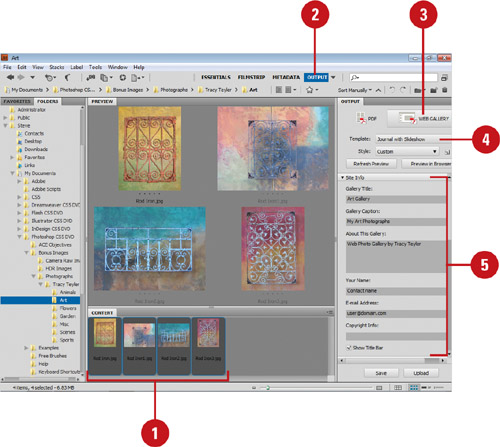
![]() Click the Workspace menu, and then click Output.
Click the Workspace menu, and then click Output.
![]() Click the Web Gallery button.
Click the Web Gallery button.
![]() Click the Template list arrow, and then select a template.
Click the Template list arrow, and then select a template.
• Click the Refresh Preview button to view your template choices or click the Preview in Browser button to see how it would look on the Web.
![]() Use the following panels to customize the Web gallery:
Use the following panels to customize the Web gallery:
• Site Info. Provide descriptive information about the Web Photo gallery.
• Color Palette. Select custom colors for screen elements.
• Appearance. Specify options to show file names, a preview and thumbnail size, slide duration, and a transition effect.

![]() In the Create Gallery panel, enter a gallery name, and then select a creation option:
In the Create Gallery panel, enter a gallery name, and then select a creation option:
• Save to Disk. Click Browse to specify a location, and then click Save.
• Upload. Specify the FTP server location, user name, password, a folder, and then click Upload.
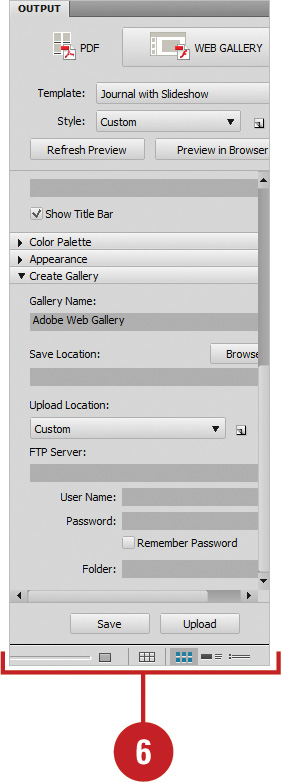
Automating Tasks in Adobe Bridge
The Tools menu provides commands you can use to automate tasks in Bridge. For example, you can automate the process of renaming a group of files using the Batch Rename command. If you use Photoshop, InDesign, or Version Cue, you can use commands on submenus to run automated tasks, such as adding and synchronizing files with Version Cue or processing raw images with Photoshop, or you can create a contact sheet of images in InDesign. You can also use the Tools menu to start other Adobe programs, such as Device Central and Acrobat Connect (Start Meeting) as well as create and edit Metadata templates, which you can use to append or replace metadata in Adobe InDesign or other XMP-enabled programs.
Rename Files Automatically in Adobe Bridge
![]() In Adobe Bridge, select the files or folders you want to use.
In Adobe Bridge, select the files or folders you want to use.
![]() Click the Tools menu, and then click Batch Rename.
Click the Tools menu, and then click Batch Rename.
![]() Select the Destination Folder option you want: Rename in same folder, Move to other folder, or Copy to other folder, and then click Browse to specify a new folder location.
Select the Destination Folder option you want: Rename in same folder, Move to other folder, or Copy to other folder, and then click Browse to specify a new folder location.
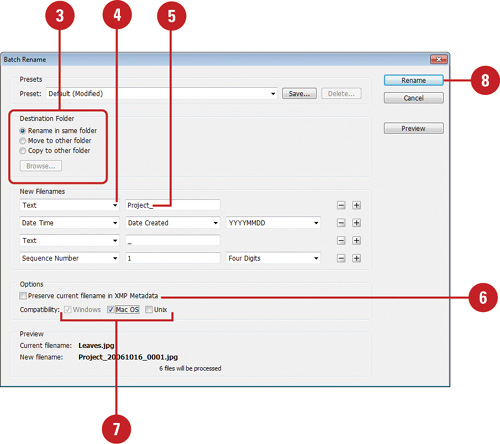
![]() Click the Element drop-down, and then select options to specify how you want to name the files:
Click the Element drop-down, and then select options to specify how you want to name the files:
• Text, New Extension, Current Filename, Preserved Filename, Sequence Number, Sequence Letter, Date/Time, Metadata, or Folder Name.
![]() Enter the text you want to use in conjunction with the Element selection to name the files.
Enter the text you want to use in conjunction with the Element selection to name the files.
![]() Select the Preserve Current File Name In XMP Metadata check box to retain the original filename in the metadata.
Select the Preserve Current File Name In XMP Metadata check box to retain the original filename in the metadata.
![]() Select the check boxes for the operating systems with which you want the renamed files to be compatible.
Select the check boxes for the operating systems with which you want the renamed files to be compatible.
![]() Click Rename.
Click Rename.
Using Mini Bridge
Adobe Mini Bridge (New!) is a condensed version of Adobe Bridge available in a panel within an Adobe CS program (Photoshop, InDesign, and InCopy). Mini Bridge allows you to directly access graphics within a CS program, where you can drag and drop them in a document. Within Mini Bridge, you can navigate to different locations on your computer, preview content, access Adobe Bridge, and set preferences for launching, appearance, and managing modules.
Use Mini Bridge
![]() Launch your Adobe product, and then start Mini Bridge:
Launch your Adobe product, and then start Mini Bridge:
• Photoshop. Click the File menu, and then click Browse in Mini Bridge or click the Launch Mini Bridge button on the Application bar.
• InDesign/InCopy. Shift+click the Go to Bridge button on the Application bar.

The Welcome to Mini Bridge screen opens.
![]() Click the Browse Files button to view files or click Settings button to change preferences.
Click the Browse Files button to view files or click Settings button to change preferences.
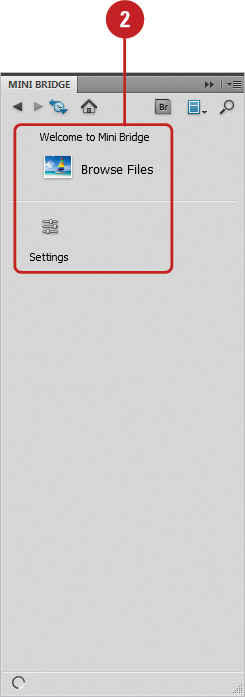
![]() Use the Navigation pod and Path bar to locate the graphics you want to view.
Use the Navigation pod and Path bar to locate the graphics you want to view.
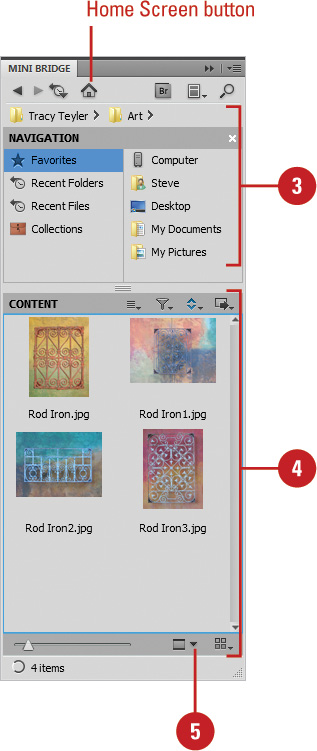
![]() Use the tools on the top of the Content Pod to sort, filter, and place files, and tools on the bottom to change the display view.
Use the tools on the top of the Content Pod to sort, filter, and place files, and tools on the bottom to change the display view.
![]() To preview files, click the Preview list arrow, and then click an option:
To preview files, click the Preview list arrow, and then click an option:
• Slide Show. Displays a slide show of the viewed files.
• Review Mode. Displays a full screen preview of the viewed files.
• Full Screen Preview. Displays a full screen preview.
• Preview. Displays a preview in the Content panel.
Exploring CS Live Services
Adobe CS Live (New!) is an online service that allows you to set up or manage (sign in and out) an Adobe account, review CS5 documents (Illustrator, InDesign, and Photoshop) online, access the Acrobat.com subscription-based Web site or the Adobe ConnectNow Web site where you can collaborate with others, display CS news and resources in a panel within CS5 programs, and access an Adobe Web site with information about CS Live Services. You can access these options directly from the CS Live menu on the right side of the menu bar next to the Search bar. When the CS Live menu icon includes a bulls eye, you are signed in to the online services.
Explore CS Live Services
![]() Click the CS Live menu (New!), and then select any of the following commands:
Click the CS Live menu (New!), and then select any of the following commands:
• Set Up Your Access To Adobe CS Live Online Services, Sign In, or Sign Out. Select to set up, sign in, or sign out of the CS Live online service.
• Create New Review or Learn More. Creates a CS5 document review in Illustrator, InDesign, or Photoshop.
• Acrobat.com Home. Opens the Acrobat.com subscription-based Web site that allows you to work and collaborate with others.
• Share My Screen. Opens the Adobe ConnectNow Web site where you can start an online meeting and collaborate on any design project across platforms and programs.
• CS News and Resources. Opens the CS News and Resources panel with news and resources from Adobe.
• Manage My Account. Opens a secure Web site with your Adobe account information after you sign in.
• Explore CS Live Services. Opens an Adobe Web site that describes CS Live Services.
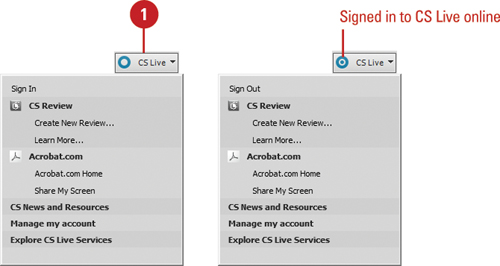
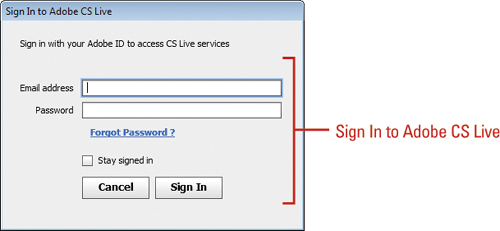
Sharing My Screen
The Share My Screen command on the File or CS Live (New!) menu allows you to connect to Adobe ConnectNow, which is a secure Web site where you can start an online meeting and collaborate on any design project across platforms and programs. You can share and annotate your computer screen or take control of an attendee’s computer. During the meeting, you can communicate by sending chat messages, using live audio, or broadcasting live video. In addition, you can take meeting notes, and share files.
Share My Screen
![]() Click the File or CS Live menu, and then click Share My Screen.
Click the File or CS Live menu, and then click Share My Screen.
![]() Enter your Adobe ID and password.
Enter your Adobe ID and password.
• If you don’t have an Adobe ID and password, click the Create a Free Adobe ID link, and then follow the online instructions.

![]() Click Sign In.
Click Sign In.
• If prompted, sign in to ConnectNow.
![]() To share your computer screen, click the Share My Computer Screen button.
To share your computer screen, click the Share My Computer Screen button.
![]() Use the ConnectNow toolbar to do any of the following:
Use the ConnectNow toolbar to do any of the following:
• Meeting. Use to invite participants, share your computer screen, upload a file, share your webcam, set preferences, end a meeting, and exit Adobe ConnectNow.
• PODS. Use to show and hide pod panels.
• Help. Use to get help, troubleshoot problems, and set account and Flash Player settings.

![]() Click the participant buttons at the bottom to specify roles, remove a user, or request control of a user’s computer.
Click the participant buttons at the bottom to specify roles, remove a user, or request control of a user’s computer.
Reviewing CS Documents
Adobe CS Review (New!) is an integrated online service that provides a simple way for CS5 users to quickly share their designs on the Web so others can provide feedback. A review of a CS5 document can be initiated from within Illustrator, InDesign, and Photoshop. Reviewers, on the other hand, don’t need the native program to perform a review. It’s all done online in a browser along with the Flash Player installed. When you provide feedback in CS Review online, the information and any comments or requests are displayed back in the originating CS5 document where the owner can respond. CS Review online provides security options to control who can participate in a review and management options to support the Review process.
Create a New Review with CS Live
![]() Open the CS5 document you want to review in Illustrator, InDesign, or Photoshop.
Open the CS5 document you want to review in Illustrator, InDesign, or Photoshop.
![]() Click the File or CS Live menu, and then click Create New Review.
Click the File or CS Live menu, and then click Create New Review.
![]() If prompted, click Sign In, enter your e-mail address and password, and then click Sign In.
If prompted, click Sign In, enter your e-mail address and password, and then click Sign In.
![]() Enter a review name, select the Add Active Document to Review check box, click OK, and then if prompted, click Continue to use the active document or Save As to use a copy of the document.
Enter a review name, select the Add Active Document to Review check box, click OK, and then if prompted, click Continue to use the active document or Save As to use a copy of the document.

![]() If prompted, specify upload settings for the document, including page range, quality, and intent, and then click Upload.
If prompted, specify upload settings for the document, including page range, quality, and intent, and then click Upload.
The CS Review panel opens.
![]() Use the toolbar buttons to display reviews and comments. You can also double-click an item.
Use the toolbar buttons to display reviews and comments. You can also double-click an item.
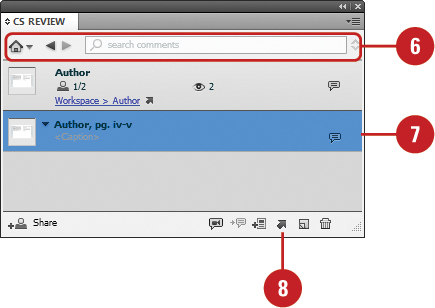
![]() Select the document you want to review.
Select the document you want to review.
![]() Click the View the Current Review Online button on the panel.
Click the View the Current Review Online button on the panel.
![]() In the Acrobat.com Web site, open the reviewer page, and use the toolbar options to add comments.
In the Acrobat.com Web site, open the reviewer page, and use the toolbar options to add comments.

Manage a Review with CS Live
![]() Click the Window menu, point to Extensions, and then click CS Review. If prompted, sign in.
Click the Window menu, point to Extensions, and then click CS Review. If prompted, sign in.
![]() Use the toolbar buttons to display reviews and comments.
Use the toolbar buttons to display reviews and comments.
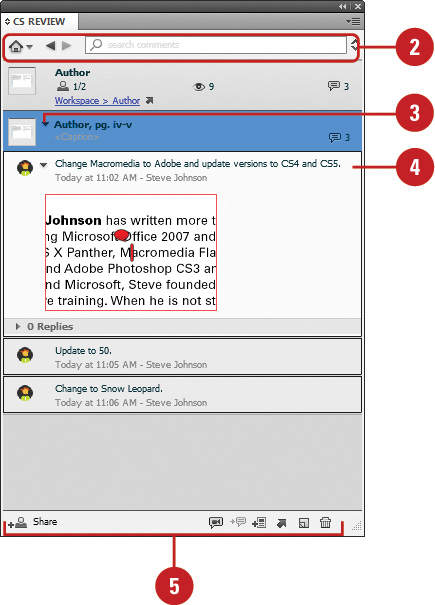
![]() Use the Down arrow to access available options:
Use the Down arrow to access available options:
• For a Reviewer. Click Open View Comments, View Online, Share, or Save As.
• For a Document. Click Open Source File, View Online, Delete Part, or Comment.
• For a Comment. Click Reply, Flag, View Online, Copy Text, Edit, or Delete.
![]() Click a comment to display it.
Click a comment to display it.
![]() Use buttons on the CS Review panel to manage reviews:
Use buttons on the CS Review panel to manage reviews:
• Invite Reviewers. Click the Share button, specify an e-mail address and role for each reviewer, and then click OK.
• Show/Hide Comments in Layout. Click the Show/Hide Comments in Layout button.
• Go to Comment in Layout. Click the Go to Comment in Layout button, and then select a file.
• Add Pages. Click the Add Pages from Current File button, click Continue or Save As, and then specify options.
• View the Review Online. Select the review, and then click the View the Current Review Online button.
• Create New Review. Click the Create a New Review button, and specify information.
• Delete Review. Select the review, click the Delete Review button, and then click Delete.
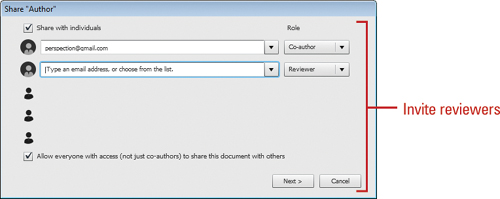

Exploring Adobe Device Central

Checking Content Using Adobe Device Central
Testing your content on as many different devices as possible allows you to reach a wider audience. Adobe Device Central makes it easy to test your content on a wide variety of different mobile devices in one place. Device Central provides a library of devices from which to choose, and each device includes a profile with information about the device, including media and content support types. Device Central uses an emulator to simulate the way your content will look on a selected device. An emulator is not the same as the real device. However, it allows you to quickly test devices to get initial results.
Check Content Using Adobe Device Central
![]() Start Adobe Device Central from the Start menu (Win) or the Applications folder (Mac) or from a CS program, click the File menu, and then click Device Central.
Start Adobe Device Central from the Start menu (Win) or the Applications folder (Mac) or from a CS program, click the File menu, and then click Device Central.
• In Bridge, right-click a file, and then click Test in Device Central.
![]() From the Welcome screen or the File menu, select the option you want:
From the Welcome screen or the File menu, select the option you want:
• Open for Testing. Opens a file for testing with the Emulator tab. Use the buttons on the mobile device to test your content.
• Device Profiles. Displays mobile device profiles. In the Available Devices panel, expand a folder with devices. On the Device Profiles tab, click links to display profile information.
• Create New Mobile. Creates a new mobile document for Flash, Photoshop, Illustrator, or other CS program; select a mobile device, and then click Create.
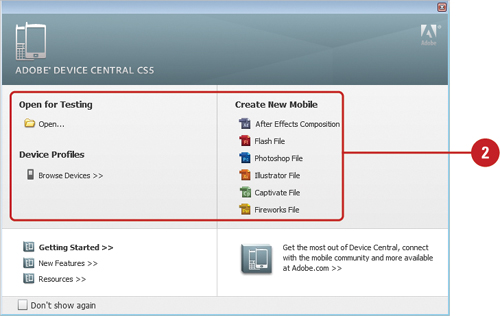
![]() If you’re testing, select the options you want in the Testing panels.
If you’re testing, select the options you want in the Testing panels.
![]() When you’re done, click the Close button in the Device Central window.
When you’re done, click the Close button in the Device Central window.

Using Adobe Extension Manager
The Adobe Extension Manager is a program you can use to install and delete added program functionality, known as extensions, to many Adobe programs. The Extension Manager is automatically installed when you install Flash, Dreamweaver, InDesign, or Fireworks. You can use the Extension Manager to access the Adobe Exchange site, where you can locate, research, and download many different types of extensions. Some are free and some are not. After you download an extension, you can use Extension Manager to install it. Extension Manager only displays extensions installed using the Extension Manager; other extensions installed using a third-party installer might not appear. After you install an extension, you can find and display information about it.
Download and Install an Extension
![]() Start Adobe Extension Manager from the Start menu (Win) or the Applications folder (Mac).
Start Adobe Extension Manager from the Start menu (Win) or the Applications folder (Mac).
Timesaver
In Flash, Dreamweaver, InDesign, or Fireworks, click the Help menu, and then click Manage Extensions.
![]() Click the Exchange button on the toolbar.
Click the Exchange button on the toolbar.
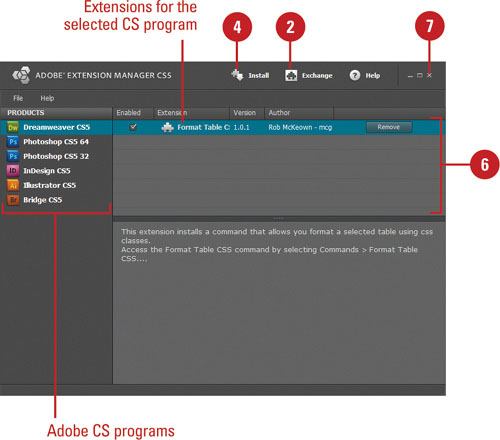
![]() Select the extension you want to download, and then save it to your computer.
Select the extension you want to download, and then save it to your computer.
![]() In Extension Manager, click the Install button on the toolbar.
In Extension Manager, click the Install button on the toolbar.
![]() Locate and select the extension (.mxp) you want to install, and then click Install.
Locate and select the extension (.mxp) you want to install, and then click Install.
![]() You can perform any of the following:
You can perform any of the following:
• Sort. Click a column heading.
• Enable or Disable. Select or clear the check in the Enabled check box next to the extension.
• Remove. Select the extension, and then click Remove.
![]() When you’re done, click the Close button in the Extension Manager window.
When you’re done, click the Close button in the Extension Manager window.

